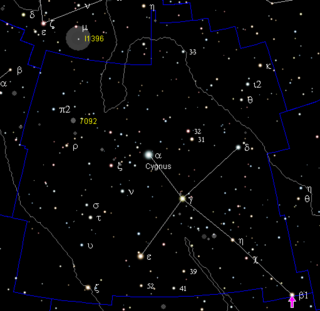Albireo
|
Double star Albireo (β Cygni) |
||||||||||||||||||||||||||||||||
|---|---|---|---|---|---|---|---|---|---|---|---|---|---|---|---|---|---|---|---|---|---|---|---|---|---|---|---|---|---|---|---|---|

|
||||||||||||||||||||||||||||||||
| Location of Albireo in the constellation Swan | ||||||||||||||||||||||||||||||||
|
Observation dates equinox : J2000.0 , epoch : J2000.0 |
||||||||||||||||||||||||||||||||
| AladinLite | ||||||||||||||||||||||||||||||||
| Constellation | swan | |||||||||||||||||||||||||||||||
| Apparent brightness | 2.92 mag | |||||||||||||||||||||||||||||||
| Astrometry | ||||||||||||||||||||||||||||||||
| parallax | 7.51 ± 0.33 / 9.95 ± 0.60 mas | |||||||||||||||||||||||||||||||
| distance | approx. 434 ly (approx. 133 pc ) |
|||||||||||||||||||||||||||||||
| Individual data | ||||||||||||||||||||||||||||||||
| Names | A / β 1 ; B / β 2 | |||||||||||||||||||||||||||||||
| Observation data: | ||||||||||||||||||||||||||||||||
| Right ascension | A / β 1 | 19 h 30 m 43.3 s | ||||||||||||||||||||||||||||||
| B / β 2 | 19 h 30 m 45.4 s | |||||||||||||||||||||||||||||||
| declination | A / β 1 | + 27 ° 57 ′ 35 ″ | ||||||||||||||||||||||||||||||
| B / β 2 | + 27 ° 57 ′ 55 ″ | |||||||||||||||||||||||||||||||
| Apparent brightness | A / β 1 | 3.1 mag | ||||||||||||||||||||||||||||||
| B / β 2 | 5.1 mag | |||||||||||||||||||||||||||||||
| Typing: | ||||||||||||||||||||||||||||||||
| Spectral class | A / β 1 | K3 II | ||||||||||||||||||||||||||||||
| B / β 2 | B8 Ve | |||||||||||||||||||||||||||||||
| B − V color index | A / β 1 | 1.13 | ||||||||||||||||||||||||||||||
| B / β 2 | −0.10 | |||||||||||||||||||||||||||||||
| U − B color index | A / β 1 | 0.62 | ||||||||||||||||||||||||||||||
| B / β 2 | −0.32 | |||||||||||||||||||||||||||||||
| Physical Properties: | ||||||||||||||||||||||||||||||||
|
Absolute vis. Brightness M vis |
A / β 1 | −2.28 mag | ||||||||||||||||||||||||||||||
| B / β 2 | −0.26 mag | |||||||||||||||||||||||||||||||
| Dimensions | A / β 1 | 5 M ☉ | ||||||||||||||||||||||||||||||
| B / β 2 | 3.3 M ☉ | |||||||||||||||||||||||||||||||
| radius | A / β 1 | 56 R ☉ | ||||||||||||||||||||||||||||||
| B / β 2 | 3.1 R ☉ | |||||||||||||||||||||||||||||||
| Luminosity | A / β 1 | 950 L ☉ | ||||||||||||||||||||||||||||||
| B / β 2 | 190 L ☉ | |||||||||||||||||||||||||||||||
| Effective temperature | A / β 1 | 4300 K | ||||||||||||||||||||||||||||||
| B / β 2 | 12000 K | |||||||||||||||||||||||||||||||
| Other names and catalog entries |
||||||||||||||||||||||||||||||||
|
||||||||||||||||||||||||||||||||
Albireo is the name for the star β Cygni (Beta Cygni) in the constellation Swan .
There are two interpretations of the origin of the name in the literature: Accordingly, the name could be derived from Arabic منقار الدجاجة / minqār ad-daǧāǧa and mean something like "beak of the hen" or derive from the ancient Greek ornis (bird).
Albireo is a well-known double star that can be separated even in small telescopes , the components of which have a clearly visible color contrast.
The double star consists of an orange-red bright giant and a blue main sequence star . The orange-red main star belongs to the spectral class K3 and has an apparent magnitude of 3.1 mag. Its luminosity is 100 times that of the sun and its diameter is 19.2 times that of the sun. The blue companion has a brightness of 5.1 mag and falls into the spectral class B8.
Both stars have an angular distance of 34 arc seconds as seen from Earth . The companion assumes a position angle of 54 degrees to the main star .
The main star is about 430 light-years away (based on the Hipparcos - astrometry ).
The annual parallax of the companion is 8.16 ± 0.25 milli-arcseconds (mas) according to Hipparcos measurements or 8.3779 ± 0.1696 mas according to Gaia Data Release 2, which is a distance of 400 (± 12) or 389 ( ± 8) light years.
Since the proper motion of the two components is very different, it is probably just an optical double star .
The IAU has on 20 July 2016 the proper name Albireo as standardized proper name for the star β 1 Cygni set. The star β 2 Cygni therefore has no proper name.
Web links
Individual evidence
- ^ Strasbourg astronomical data center . Retrieved June 1, 2018
- ↑ Gaia Collaboration. Gaia DR2 https://gea.esac.esa.int/archive/ Retrieved June 1, 2018
- ^ Hipparcos, the New Reduction (van Leeuwen, 2007)
- ↑ Gaia data release 2 ( Gaia DR2 ), April 2018
- ↑ Bulletin of the IAU Working Group on Star Names, No. 1, July 2016. (PDF) Retrieved November 9, 2016 (English, 184 KiB).

